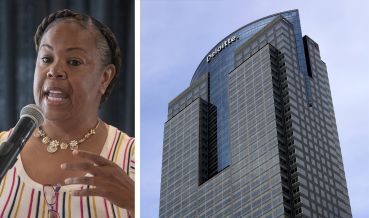New York City’s Office REITs Struggle With Steep Stock Declines
The declines spark speculation of an existential crisis in what once looked like a foolproof business model
By Brian Pascus April 13, 2023 3:43 pm
reprints
For New York City’s premier office real estate investment trusts (or REITs), Armageddon — or at least the ominous dark clouds and thunderclap that are supposed to precede the end of times — appears closer than ever. In fact, it might already be underway.
Several of New York’s largest commercial real estate owners have seen stock market declines over the last 12 months that have exceeded 50 percent and wiped out billions of dollars in both shareholder value and desperately needed equity for these office sector titans.
The stock price of SL Green (SLG) Realty Corp., one of New York City’s very largest private holders of office space, has declined 67 percent since April 2022; Boston Properties (BXP), which oversees more than 12 million square feet of office space in New York, including majority ownership of the General Motors Building at 767 Fifth Avenue, has watched its stock fall by 56 percent since last April; and American Strategic Investment Corp. (formerly NYC REIT), owner of 1.2 million square feet and eight properties in New York, has experienced an 87 percent stock price decline year to date. But that’s just three examples. Nearly every office REIT has seen their stock prices take a beating since this time last year.
“The main reason the low stock price should be concerning is the market’s participants think this business is worth much less than it used to be,” said Tomasz Piskorski, professor of real estate at the Columbia Business School. “And in a sense it is: Interest rates are higher, there’s less demand, and now there’s work from home.”
Even if their stock price isn’t plummeting, the city’s most prominent office REITs are still encountering other unforgiving threats against a background of economic uncertainty.
Some — like Paramount Group, owners of 11 New York office properties, including Paramount Plaza at 1633 Broadway and 1301 Avenue of the Americas -– have fended off a pair of investor takeover attempts amid stock price declines. Even the biggest players — such as Vornado Realty Trust, which watched Mark Zuckerberg’s Meta abandon a 300,000-square-foot office at 770 Broadway last July and hastily ended plans earlier this year for a massive $7 billion project to reinvent the office district around Penn Station — have lost major tenants and seen cherished expansion plans collapse.
“The most fascinating topic across the [real estate] spectrum is New York office REITs,” said David Auerbach, managing director of Armada ETF Advisors, an asset manager specializing in REITs. “If we didn’t have this work-from-home situation happening, I’d say it’s a blip on the horizon, but we know that work from home is here to stay, no matter how many ways these guys try to slice it and dice it.”
The executive leadership at some office REITs have acknowledged, however reluctantly, that they’ve entered a brave new world of tenant occupancy.
“The hybrid model has persisted far longer than I expected it to,” said Marc Holliday, SL Green’s CEO, when asked in December at the firm’s investor day about the staying power of remote work.
“You can assume that Friday is dead forever. Monday is touch and go,” answered Steven Roth, founder and chairman of Vornado, when asked about commuter habits during an earnings call in February.
At the heart of the problem lies people. COVID-19 permanently altered the daily commuting patterns for vast swathes of the workforce, especially white collar workers. For many New Yorkers, returning to the office five days per week seems almost as unlikely as taking a horse-and-buggy to get there.
Data from Kastle System, a firm which measures back-to-work metrics, showed that only 48.5 percent of New York metro area offices were occupied during a typical workday the week beginning April 3.
And there could be more threats to in-person work on the horizon. New technologies such as artificial intelligence, augmented reality, and enhanced video conferencing will likely threaten the survival of some white collar work and further dilute the practical use of office space in the near future, according to Nitin Chexal, CEO of Palladius Capital Management, an alternative lender.
“There are so many technologies coming out there that are eliminating the need for personnel, as well as the need to be in-person, physically in person, and that’s going to have an effect on the demand for office space — that’s the reality,” he said. “You’re always going to have a need to gather, but technology is going to accelerate the trend of functional obsolescence for office as an asset class, over time.”
None of this is good news for New York’s biggest office REITs, which are counting on long-term leases anchored by dependable corporate tenants to pay off billions of dollars in commercial mortgage-backed securities. New York’s office landlords have 89 loans totaling $15.7 billion supported by 129 properties that mature by 2024, Commercial Observer reported in February. Among those are Vornado’s $950 million loan on 1290 Avenue of the Americas due to mature in November, SL Green’s $200 million debt on 185 Broadway that comes due in November, and a $1.1 billion loan on 280 Park Avenue owned jointly by SL Green and Vornado that matures in September.
There have already been tremors in the system across other national markets. Earlier this year, PIMCO-controlled Columbia Property Trust defaulted on a $1.7 billion loan for seven buildings in multiple states, while Brookfield (BN) defaulted on a $784 million loan for two buildings in Los Angeles.
“There is tremendous uncertainty [stemming] from work from home,” Piskorksi said. “There’s a risk in 10 years that working in an office building becomes as obsolete as working on the floor of the stock exchange, trading stocks. They may become dinosaurs.”
Before COVID-19, offices were traditionally a dependable source of income for REITs and investors alike, one that was reflected in the confidence given by the market. On Feb. 14, 2020, SL Green’s stock price stood at $100.81 per share, Vornado’s $67.89 and Boston Properties $147.23.
“They were buying the assets everyone wanted to own, they were buying well-located, scale offices with mixed-use, sometimes with retail on the bottom, in a city that had global demand for occupancy,” said Manish Shah, senior managing director at Palladius Capital Management. “In the business they’re in, when you have really excellent credit tenants, you have an excellent business.”
The unique business model of office REITs made them popular with investors prior to COVID-19. As landlords who lease space and collect rent on their properties, REITs distribute that income as dividends to shareholders. Their tax structure requires them to pay a minimum of 90 percent of taxable income to shareholders as dividends each year.
But multiple New York City office REITs have cut dividends recently in an attempt to shore up their balance sheets, preserve capital, and finance operations among cratering stock valuations and increasing vacancies brought on by tenants who realize they can reduce occupancy costs.
Vornado cut its dividend by nearly 30 percent in January, saving itself nearly $30 million in the first quarter; SL Green cut its dividend in December by 13 percent; and American Strategic Investment suspended its dividend altogether last July to save a $1.3 million quarterly dispensation.
“What’s affecting some of these guys is the fact they cut their dividends,” explained Auerbach. “That does leave a sour taste in investors’ mouths when some of the biggest players in the New York office space [do that].”
Perhaps most concerning for New York’s office REITs is the invisible presence of inflation and the Federal Reserve’s decision to raise its benchmark interest rate from near zero to nearly 5 percent to fight one of the most frightening of economic maladies.
Michael Ashner, currently the chairman and CEO of Winthrop Capital Partners who was the former chairman and CEO of Winthrop Realty Trust, a REIT traded on the New York Stock Exchange, said that the fundamental problem REITs have always faced is the difference between their intrinsic leverage — what they borrow to buy each asset — and the extrinsic leverage — what the market says their leverage ratio is, which is based on market valuation of their equity.
“So you have an upward spiral: when interest rates go down, a decently managed company should have its equity enhanced and would look to the world as less leveraged, more valuable, with less risk,” Ashner said. “But when interest rates go up and recession hits, it goes completely the other way, reducing the company’s valuation and creating a downward spiral.”
REITs are liquidity beasts, Ashner explained, in that their valuations are dependent on how the world looks at their leverage. And there is not necessarily a correlation between what they borrow — both secured and unsecured — against the assets that they purchase compared to the market valuation of the company (i.e. the amount of equity in the stock price and the aggregate debt), he emphasized.
“It’s never perfect,” Ashner said. “The companies are often either undervalued or overvalued.”
One place to find a more accurate picture of the health of New York City’s largest office REITs is in their fourth quarter supplemental reports issued to investors at the end of each year. Here, REITs report their overall Funds From Operations (FFO), a measurement of cash flow from operations that considers depreciation, amortization, sales of assets and interest income.
SL Green’s FFO payout declined by nearly 5 percent in 2022, falling from $481.2 million to $458.8 million; Empire State Realty Trust, owner of the iconic Empire State Building and also a 9.6 million-square-foot office and retail portfolio, saw its FFO payouts increase year-over-year but experienced a drop of 25 percent between the second quarter of 2022 and the fourth quarter, declining from $79.1 million in June 2022 to $58.7 million in December 2022, according to each firm’s fourth quarter supplemental report to investors.
Even the firms that generated strong FFO payouts this past year are hampered by other threats within their portfolios.
While Vornado’s FFO payout increased by 12 percent, rising from $611 million to $686 million, the firm is saddled with more than $2.3 billion in floating rate debt (which experiences borrowing cost increases in high interest rate environments — like now), roughly 27 percent of its total debt commitment, according to its supplemental report.
Paramount Group, whose FFO payment increased by 9 percent from $192 million to $210 million this past year, is weighed down by roughly $3 billion in consolidated debt on several Manhattan and San Francisco office properties, with 63 percent of that debt due between 2023 and 2026, according to its fourth quarter supplemental report.
“Their debt is probably a lot higher as a percentage than it was before the stock price dropped, as the stock price represents equity, but the debt is still the same, but as a percentage it’s much greater [than before],” said Jonathan Morris, professor at Georgetown University and founder of the REIT Academy.
And, while the end of times might indeed be underway for New York City’s office REITs, several experts within the CRE industry believe almost all of these firms have the leadership in place — and valuable enough portfolios — to pivot into whatever office space transforms into in the 2020s and beyond.
Joseph Shanley, head of acquisitions at Haven Capital, a real estate investment firm focused on ground leases, said these office REITs have options: They can creatively capitalize their assets through office-to-apartment conversions and by selling off non-core assets to protect those that have perpetual value.
“If you’re taking both a creative approach to the way you structure your business and fortifying those assets that will be the future of your platform, you’re likely putting yourself in a position to weather the storm and take advantage of interesting opportunities that should shake out over the next few years,” he said.
To this end, there’s been a true flight to quality for the newer, greener office towers constructed in recent years. Despite opening in the throes of the pandemic, SL Green’s 1 Vanderbilt has been an indisputable success and stands at about 99 percent leased, while the Hudson Yards project has revitalized the entire Far West Side of Manhattan.
“What are the winning cards you want to hold? Incredibly modern or redeveloped office that’s convenient for commuters,” said Alexander Goldfarb, managing director at Piper Sandler, an equity analyst. “Look at the success the Far West Side has had: it’s not even logistically convenient, but people want that new office.”
But it also takes a neighborhood to raise a successful office, and as 1 Vanderbilt and JPMorgan Chase’s upcoming 270 Park Avenue headquarters assert their roots as foundations of the Grand Central Terminal district in the east, and Hudson Yards and 1 Manhattan West anchor the Penn Station district to the west, the continued utilizations of these areas by workers returning with their feet will be the strongest indicator to come of what future office space development looks like in New York City.
Shah said that when he speaks to CRE executives, the prevailing belief is that any desirable New York office space must be centrally located and compliant with green environmental regulations, and that for any inventory which lacks those characteristics — notably Class B and C office properties that make up the bulk of the city’s office — it must be converted or upgraded to meet those needs now and into the future.
“The people that run these firms are really smart and have been around a while. Given time, they’ll find value and ability to create value in real estate,” said Shah. “The question is what do the public markets do in between while they’re turning the ship?”
None of the REITs mentioned in this article responded to requests for comment or accepted an interview request.
For now, given the fickle nature of the market and the bad headlines that appear almost daily about the impending demise of commercial real estate, the best thing these office REITs can do, according to Auerbach, is wait for the business cycle to improve and lean into the unique characteristics that make New York City the capital of finance, media and culture in the United States.
“There’s only one New York. There’s only one San Francisco, only one Chicago,” Auerbach said. “You can’t replicate outside of New York the live, work and play lifestyle, the buzz that city has.
“Look at Times Square in the 1970s,” he added. “Just like any other previous cycle, it goes through waves, and, right now, New York City office is extremely out of favor, but, for the risk-tolerant crowd, you could be buying some of these names trading at deep discounts, and, if you’re willing to take pain today, those are the guys having the last laugh.”
Brian Pascus can be reached at bpascus@commercialobserver.com.


